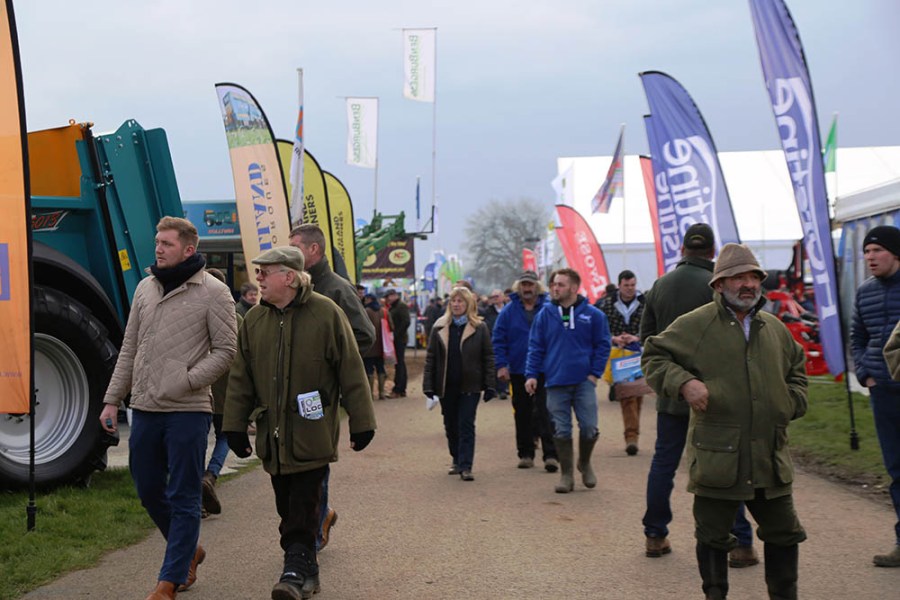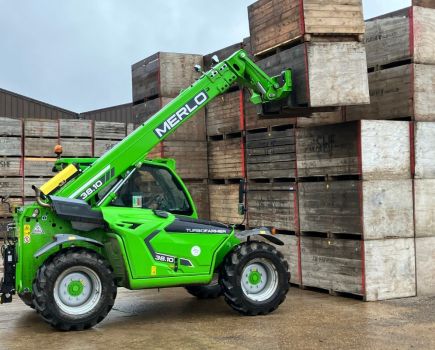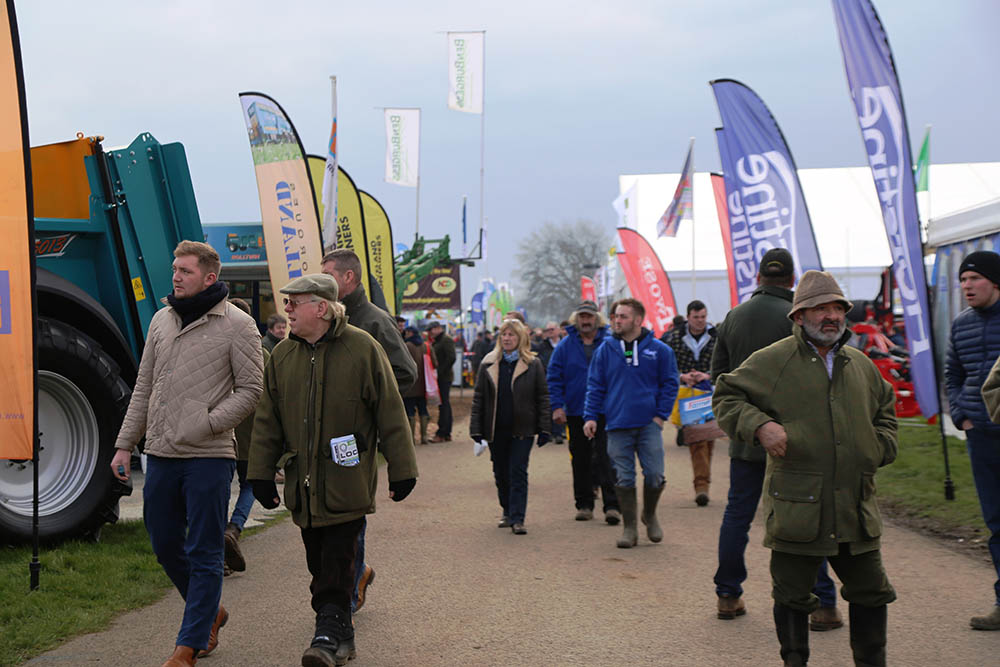 While many visitors to LAMMA now head first to the enormous tents housing the multi-national giants, the event still stays close to its roots providing a shop window for many British manufacturers. CPM takes a look at the latest developments.
While many visitors to LAMMA now head first to the enormous tents housing the multi-national giants, the event still stays close to its roots providing a shop window for many British manufacturers. CPM takes a look at the latest developments.
I’d like to think farmers still like the idea of buying British
By Mick Roberts
LAMMA first began, back in the early 1980s, as a showcase for equipment produced by Lincolnshire Agricultural Machinery Manufacturers Association – hence its name. While the show may have changed immeasurably, you can still find many of the original exhibitors, particularly those making sprayers, drills and cultivators.
Although Britain’s farm machinery sector may have shrunk in the past twenty years, some sectors continue to remain strong. This year’s catalogue, for example, lists no fewer than 14 different British sprayer manufacturers, many of which are based in Lincs and in the surrounding counties.
In the face of the onslaught of the new machines launched at the Agritechnica show by their European-based rivals, the UK sector fought back at LAMMA with new developments, some interesting innovations and a big surprise.
In an age when it’s almost impossible to move without it being tweeted, shared or posted, it was a real surprise to see the new Knight forward-control, self-propelled sprayer based on the latest JCB 4220 Fastrac making its debut at LAMMA. Attracting much attention from visitors, it soon became the talk of the show.
With its 4t payload platform the latest Fastrac, like its predecessors, is a logical host for a sprayer. But removing the cab and placing it up front creates even more room for the spray pack. It also provides a 50:50 weight distribution when fully laden, and offers as good, if not better visibility, as other self-propelleds.
“One of the reasons we chose to work with JCB Agriculture and use its 4000 Series for this application is that the cab offers such outstanding visibility, especially the panoramic rear screen,” says Brian Knight.
The Fastrac also comes with an AGCO-built continuously variable transmission (CVT) as standard, which puts the Knight sprayer in the unique position of providing mechanical drive, but with an infinite speed control. The high spec continues with hydro-pneumatic suspension, all round air disc brakes, a high, legal top road speed plus the ability to tow a large bowser.
Knight says it had to make only a few changes to convert the tractor to a sprayer, but one of the most important was to accommodate the 380-90-R46 Michelin SprayBib tyres and to move the original mudguards. The linkage is removed entirely and there are also new fuel, AdBlue and oil tanks, built to allow the fitting of the spray pack.
The vehicle can be supplied with tanks up to 4000 litres and with booms up to 40m wide, which are equipped with the Maximiser pressurised circulation system with air-operated nozzles. Distance control II 4D active suspension/levelling system is an option.
Kellands takes a different approach with its MultiDrive, keeping the cab in the middle, which suits its often multi-purpose role. On the latest M380-4 model this results in a long bonnet up front, which sports a snazzy new style to accommodate the new Cummins engine that takes over from the previous Deere Power Systems (DPS) motor.
One of the main reasons for the change to Cummins is that its 6.7 litre engine’s more compact SCR system used to meet the Stage IV emission regulations, which allows it to fit under the bonnet. The 225hp Cummins now provides 17% more power and a 20% increase in torque.
Other changes include new hydraulic cab mounts, which reduce noise and vibration. In the cab there’s a new floating control console and a joystick with thumb-wheel controls to switch between manual and automatic transmission modes. It’s also equipped with a new colour screen terminal that, among other functions, displays images from cameras mounted in the bonnet allowing operators to see what’s coming from either side. There’s also a reversing camera.
A new off-set steering mode is said to increase traction and improve control while working on slopes. Capable of carrying a 10t payload, the MultiDrive will handle a 5000-litre spray tank or an 8t spreader hopper as well as haul an 18t load at 50km/hr.
The trailed sprayer sector saw a new entrant and a range of machines introduced at last year’s Agritechnica show, but domestic manufacturers continue to lead sales in the UK. Chafer got its response to the European offensive in first, with last summer’s launch of its new Guardian Series, which was on show at LAMMA for the first time.
“The new machines, particularly the ‘e’ models have been well received by customers,” says the firm’s Joe Allen. “We developed the electronics in-house and have not only responded to customers’ needs during the design process, but we can also tailor the system to individual requirements. We feel that although the ISOBUS standard has its benefits, the drawback is it’s quite prescriptive. Using our own software allows us to provide different and extra functions that many operators are finding useful.”
With the launch of the new Leader 4 range at LAMMA, Team Sprayers is also responding to its customers’ requests for higher specifications, with the new machines including previously popular options as standard.
“I’d like to think farmers still like the idea of buying British,” says Danny Hubbard. “We’re a family business and make virtually everything on our machines in Ely. But we still need to provide what the customers’ want.”
The Team Leader 4, he adds, has been developed in response to dealers and customers’ requests and is a radical departure from its previous designs, including a range of modern features, which were often taken as options on existing models.
The design and position of the new polypropylene tank helps lower the centre of gravity and is available in 3000, 4000 and 5000-litre capacities. There’s a twin air bag, load-sensing suspension and the axle is equipped with a new steering system. The new, low folding boom is available in widths from 18m to 24m with double folding or with triple on 28m, 30m and 32m.
The spraylines are protected inside the boom structure and are equipped with an air shut-off recirculation system. A Müller terminal provides automatic rate control as well as operating the boom folding and steering system either through the screen or with the standard joystick.
Lite-Trac is continuing to develop its Dual Use boom, which can be used to apply as granular products at the same time as liquids through the spraylines. Hollow sections in the boom’s structure are used to transport granules from a 900-litre capacity hopper to the 24 distribution outlets, spaced at 1.5m. Heat from the hydraulic hoses that drive the fan is used to help dry the air to prevent product sticking in the pipes.
The boom can apply liquid and dry products at the same time and at variable rates with control from the Trimble FmX terminal. This also provides auto-section control for both systems.
While the Drone that Crop Angel plans to use for spot spraying is made in China, it’s Norfolk-based agronomist Matthew Kealey’s idea to use his experience to provide an aerial application service.
The drone can carry 20 litres of liquid and applies sprays through standard hydraulic nozzles fitted beneath each rotor. It offers an application width of about 3m, with the blades helping to force the chemical down into the crop.
“We’re already looking closely at bracken control,” he says. “This provides a far more efficient and cost effective treatment compared with the cost of aerial application by helicopter.
His idea is to create a franchise service across the country with contractors providing the service using operators who are trained and qualified to not only fly the drone, but also apply pesticides. “The drone is equipped with GPS and in the future we plan to be able to fly and apply pesticides according to spot-treatment plans,” he adds.
Britain cultivates ideas
New cultivation ideas on show at LAMMA for the first time included the first and only new British-built plough, shallow seedbed makers along with further developments in drilling and establishment.
The new Hubert plough range, which made its debut at LAMMA, takes its name from Agri-Hire managing director Tim Hubert.
After Dowdeswell went into liquidation in 2015 Agri-Hire, its largest UK dealer, continued to supply genuine parts to existing users. While working with customers the company realised there was substantial pent-up demand for a replacement for the well regarded plough.
“Agri-Hire has its own engineering division, which is already well known for manufacturing a range of manure spreaders and trailers,” says Tim Hubert. “So we decided to fill the gap by making the new plough range using genuine Dowdeswell wearing parts.”
The Hubert range is built using the latest materials and engineering expertise, he adds. They’ll be available with five to nine furrows, fully mounted with vari-width and a choice of Dowdeswell bodies.
For those who’ve moved away from traditional establishment methods, Claydon has introduced a new shallow cultivator designed to move more soil than its existing straw harrow.
The TerraStar uses special ‘star’ points to create a tilth to encourage weeds and volunteers to chit as well as to control slugs, but still leave the soil structure intact. The shallow cultivation is achieved using ‘stars’, each with four knife blades – providing a total of 68 points. These are said to create 80mm square divots in the top layer of the soil in a 200mm grid pattern to a depth of about 30mm, which creates a tilth, while still allowing the surface to support machines.
An additional tool in the Claydon system, the Terrastar goes in first after the combine, and its shallow tilth is said to stimulate both blackgrass seeds and volunteers to flush. It’s then followed up to every 10 days with the harrow to knock out any plants that have germinated and stimulate further weed flushes. The Terrastar is especially handy where soil conditions after harvest are a little too tight to achieve a decent weed flush with the harrow, says Claydon.
The 6m wide TerraStar has a power requirement of at least 150hp and is designed to work at about 15km/h, providing a workrate of about 9-10ha/hr.
Dale Drills has introduced the 12m wide ECO Max drill, which fits into common controlled traffic systems, as well as providing higher outputs for other users. With a power requirement of about 20-30hp/m it offers a daily output of about 100ha.
The ECO Max follows the Dale Drills format, with 96 seed units on 48 drilling assemblies. The wider model, however, offers larger clearances with a new A-frame that’s 275mm longer than the ECO drill. The distance between the tines has been extended by about 110mm to provide a clearance of 750mm. Row spacings can be set between 125-250mm for cereals and up to 500mm for oilseed rape.
Sumo is now offering mounted toolbar versions of its DD direct drill and DTS, strip-tillage machines, which are designed to work with a front-mounted hopper. The 4m wide toolbar version of the DD4 retains all the same elements as the existing machine, using 450mm discs set at an angle to open the slot. The strip-till DTS toolbar is 3m wide and, like the DD, also remains unchanged. Sumo suggests using the front hopper and buying both toolbars to form a modular system, using either drill to suit the conditions.
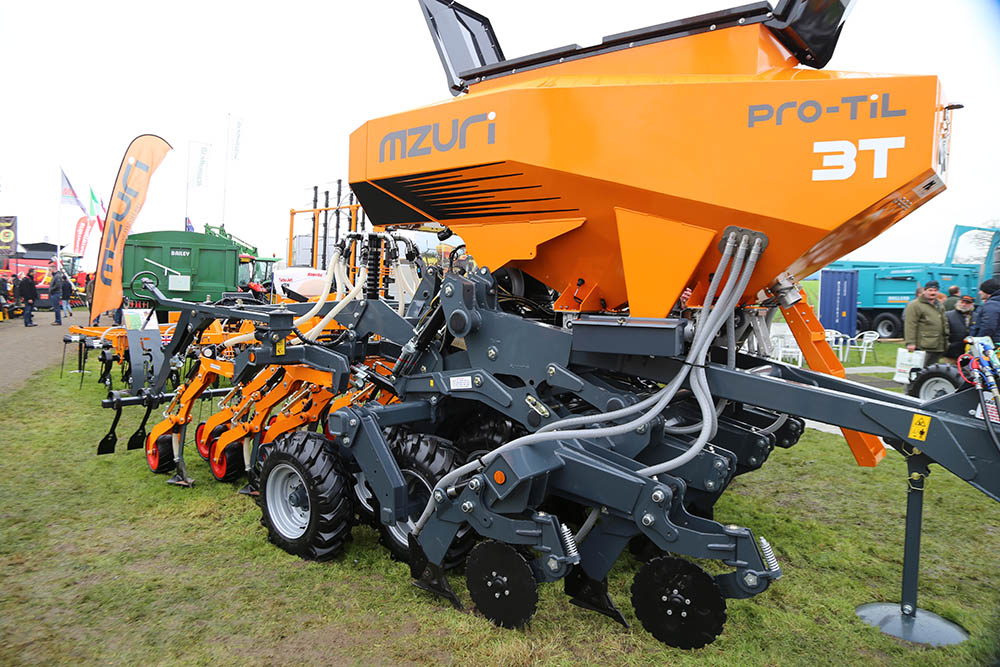
Operators can switch between five and nine-leg sowing at the touch of a button on the latest 3m Mzuri Pro-Til 3T ‘Select’ drill.
Meanwhile, the latest 3m Mzuri Pro-Til 3T ‘Select’ drill offers the opportunity to change between wide and narrow drill spacings at the touch of a button.
The ability to change widths provides a number of benefits, says the firm’s Martin Lole. “It means operators can use the machine conventionally for all combinable crops with the nine-leg option, but with the touch of a button select the five-leg configuration to sow OSR, cover crops and maize,” he explains.
As strip tilling becomes more widely accepted, users are looking at using the technique in a wider range of crops. The latest joint i-Tillage development by Cousins of Emneth, working in conjunction with Hutchinsons, is designed to sow sugar beet using the V-Form soil loosener equipped with Micro-Wing legs.
The development works in a similar way as the set-up for sowing OSR, but uses an additional leg. For sowing beet seed the Micro-Wing is set to a depth of about 50-75mm to create a tilth for the seed, while the second leg works at a depth of at least 175mm to provide deeper loosening. A following zonal roller compresses only the soil that has been moved.
“Strip-till sowing sugar beet offers big savings in costs, without any yield penalty,” says Hutchinsons’ Dick Neale. “It also provides the additional benefits of reducing weeds and helping to prevent wind blow.”
Great Plains’ Spartan 607 direct drill made its debut at LAMMA, along with a range of other machines it launched at Agritechnica in Germany last year. The 6m wide drill uses the firm’s proven 07 Series opener, is equipped with a new seed tower based on a similar design to that used on the Centurion cultivator drill. This now provides a range of new features as well as a new variable rate system and push-button seed calibration.
Also on show were the new generation of mounted and trailed X-Press cultivators (see CPM Dec 2015 issue for details).
Euro LAMMA line-up
While the latest He-Va 3m trailed Combi-Disc is built in Denmark, it’s design is based on feedback from UK customers, says Opico’s James Woolway.
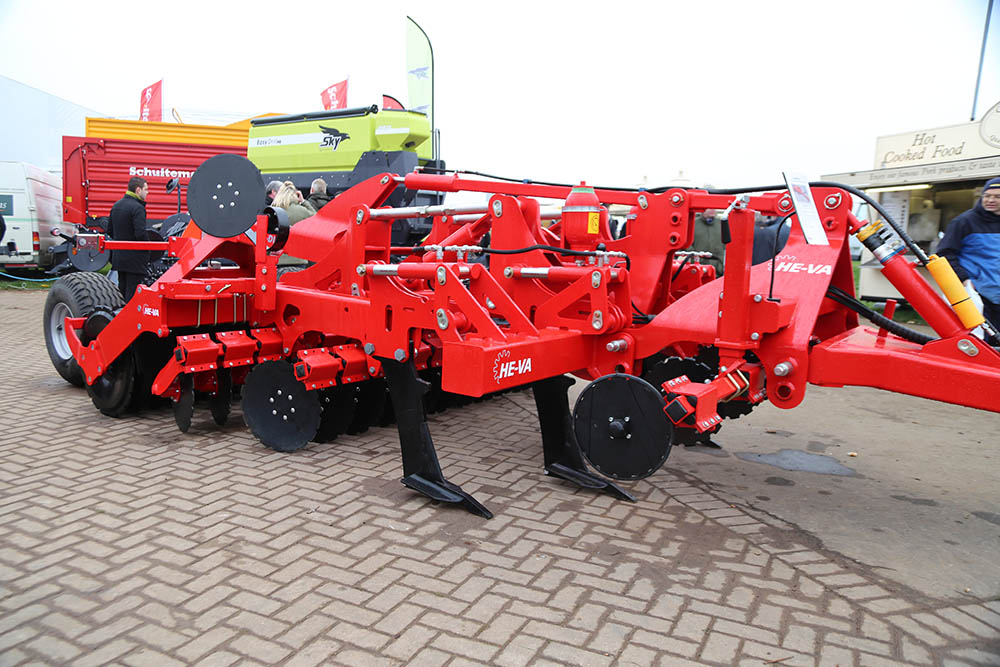
The new trailed 3m He-Va Combi-Disc, one-pass cultivator also comes with the option of a low disturbance disc opener.
“The trailed model provides the same deep soil-loosening and surface cultivation in one pass as the mounted version, launched last year. Users said they particularly like the ability to adjust the working depth of both elements, hydraulically from the cab.
“This new version reduces the load on the linkage, which means the power requirement isn’t determined by the tractor’s lift capacity. In some cases, this means it can be used with smaller tractors. It’s also easier to transport on the road,” he explains.
Also new on the trailed model is an optional low-disturbance disc opener, which uses a disc to slice through the top layer in front of the subsoiling leg. This reduces the surface ‘burst’ of soil, which helps keep blackgrass seeds buried.
The first direct drill from Horsch made its LAMMA debut. Available in 4m, 6m and 12m working widths, the Avatar SD combines a new single-disc seeding system with the hopper and metering system from the Pronto DC model.
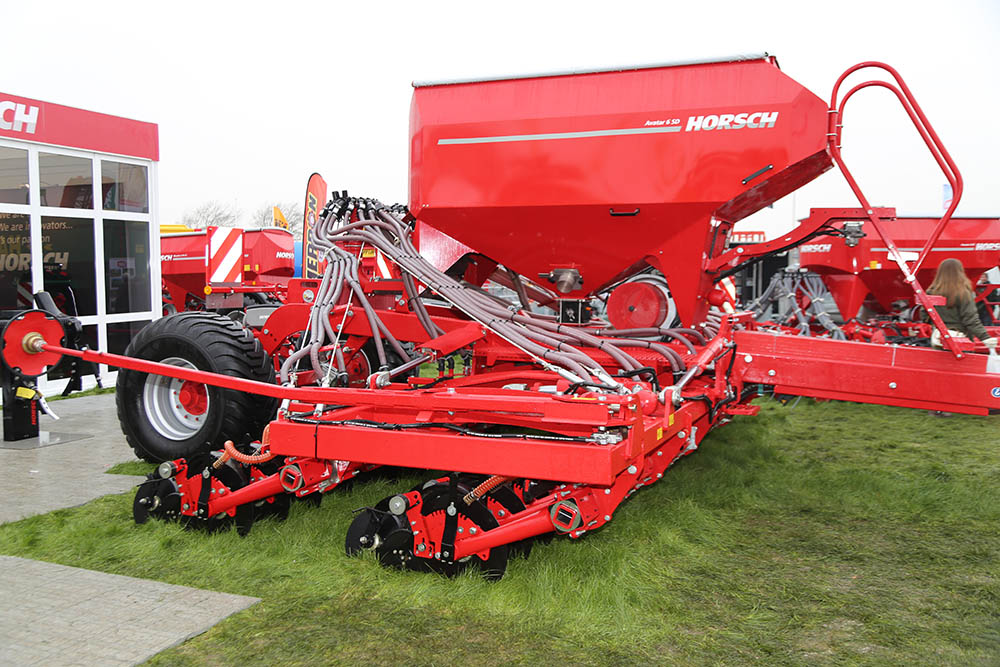
The Avatar is the first direct drill from Horsch and uses two rows of new single disc coulters, along with the hopper and metering system from the Pronto DC.
The coulters, which are arranged in two rows, use a straight disc to slice through trash, working ahead of a smaller, angled opener disc and seed coulter. A steel, angled press wheel consolidates the soil on the seeding slot. It provides 16.7cm row spacings on the 6m wide model or 20cm on the 4m and 12m versions.
Drilling depth is controlled by a larger, stronger version of the Pronto rubber suspension system, which is able to apply up to 200kg of coulter pressure. An ISOBUS terminal is standard.
The long awaited Lemken Vega trailed sprayer made its first UK appearance at LAMMA. The first trailed model to be developed entirely by the German manufacturer, it provides a high specification as standard as well as a range of options.
There’s a choice of 3000, 4000 and 5000-litre capacity, moulded plastic tanks. All are positioned low in the chassis to help lower the centre of gravity and the sculpted shape is also designed to hold a minimum residual liquid and easy emptying and cleaning.
The Vega 12, which is likely to be the main model in the UK, is equipped with SEH aluminium booms, which fold vertically at the rear and are available in widths from 15-24m. The spraylines run inside the boom structure with the liquid recirculation system that continuously delivers liquid to all sections. This provides instant starts with individual nozzle control provided by the Eltec Pro system.
Two pumps are fitted as standard – one for spraying and the other for filling – providing outputs of 200 or 260 l/min.
A steering drawbar and pneumatic axle suspension will be standard on the UK-spec Vega 12 models in the UK.
Future of spray research centre secured
The future of the Silsoe Spray Applications Unit has been secured following its acquisition by Robert Willey, the owner of the Lincs-based, Househam Sprayers.
The Silsoe Spray Applications Unit is a world-renowned research centre that has been responsible for some of the most innovative developments and practical application advice.
“The Silsoe Spray Applications Unit is an internationally important facility,” says Robert Willey. “At a time when the application of crop chemicals is coming under increasing scrutiny it’s particularly important that the unrivalled expertise of the staff and the high quality facilities at Silsoe are not only protected, but also enhanced to offer highly professional and independent services to the whole crop protection sector.”

